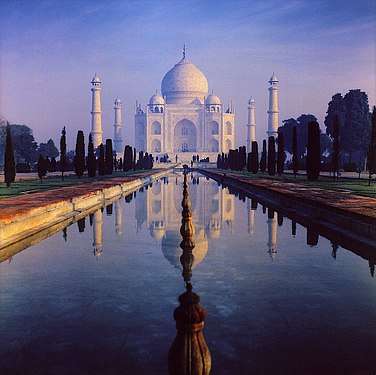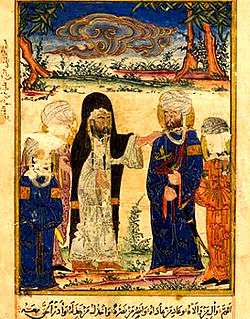Event of Ghadir Khumm
The event of Ghadir Khumm (Arabic: حَدِيْث ٱلْغَدِيْر, romanized: Ḥadīth Al-Ghadīr; Persian: رویداد غدیر خم) refers to a sermon delivered by the Islamic prophet Muhammad at the Pond of Khumm (Arabic: غَدِيْر خُمّ, romanized: Ghadīr Khumm), shortly before his death in 632 CE. According to Shi'ite traditions, in the sermon Muhammad announced Ali ibn Abi Talib as his successor, after which the final verse of the Quran was revealed, proclaiming the perfection of the religion of Islam. The day's anniversary in the Islamic calendar (18 Dhu al-Hijjah) is celebrated by Shi'ite Muslims as Eid al-Ghadir.
| Event of Ghadir Khumm | |
|---|---|
Mosque at Johfah near Rabigh in Hejaz, Saudi Arabia. The event is reported to have occurred somewhere here. | |
| Also called | Eid Al-Ghadeer |
| Observed by | Muslims, mostly Shi'ites |
| Type | Islam |
| Significance | Appointment of Ali as the successor of Muhammad; completion of the message of Islam (Shi'ite view) |
| Observances | Prayers, gift-giving, festive meals, as well as reciting the Du'a Nudba |
| 2020 date | 8 August[1] |
| Part of a series on |
| Islam |
|---|
 |
|
| Part of a series on |
| Muhammad |
|---|
 |
|
Views |
|
Related |
|
| Part of a series on |
| Ali |
|---|
 |
|
Perspectives |
|
Related articles |
|
 |
| Part of a series on |
| Islamic culture |
|---|
| Architecture |
| Art |
|
| Dress |
| Holidays |
|
| Literature |
|
| Music |
| Theatre |
|
The event of Ghadir Khumm occurred while the Muslims were returning from the Farewell Pilgrimage. According to Shia belief, a verse of the Quran was revealed instructing Muhammad to deliver an important message. The Muslims were gathered and Muhammad delivered a lengthy sermon. The speech included the famous statement by Muhammad that "Anyone who has me as his mawla, has Ali as his mawla". Shi'ites interpret this phrase to be the designation of Ali as Muhammad's heir, though this is disputed by Sunni Muslims. Shia traditions also state that the last verse of the Quran, which is the third verse of Al-Ma'idah (the fifth chapter of the Quran), was then revealed: "This day I have perfected your Religion for you: Completed My favour upon you, and have chosen for you Islam as your Religion."[2]
While Sunnis hold little significance to Ghadir Khumm,[3] Shi'ites consider it to mark the completion of Islam[4] as well as the official appointment of Ali as Muhammad's successor.[2]
Historical sources
Most historical sources regarding the life of Muhammad (such as Al-Tabari, Ibn Hisham and Ibn Sa'd)[note 1] either make no mention of Ghadir Khumm or, if it is acknowledged, avoid discussion of Muhammad's address. However, it is probable that such writers purposefully abstained from commenting on the event so as to not anger the Sunni rulers of the time; such discourses could have been used to provide potential fodder for Shia claims to Ali's right to the caliphate. It cannot be doubted however, that Muhammad had spoken at Ghadir Khumm and had given the legendary statement simply due to the sheer number of well-attested hadiths which mention the event.[5] Shia sources claim that over a hundred Sahaba and eighty-four Tabi'un recount the event with different chains of transmission.[7] Preservers of such accounts include Shi'ites, such as Ya'qubi, as well as Sunnis like Ahmad ibn Hanbal in his famous Musnad, with the traditions recorded in the latter generally being considered canonical.[5]
While the authenticity of the event is not contested, its interpretation is a source of controversy between Sunnis and Shias.[8] The Sunni historian Ibn Kathir for example, while himself having collected a huge number of hadiths regarding Ghadir Khumm, states that they supply no basis for Ali's succession.[5] Conversely, the Iranian scholar Abdul Hosein Amini compiled eleven volumes worth of sources in support of the Shia view.[6] However, notable in its lack of mention of Ghadir Khumm is the Al-Sahifa al-Sajjadiyya, attributed to the Fourth Shia Imam and considered by some to be the third holiest book in Shia Islam.[9][note 2] Having provided special prayers for the "two great feasts" of Eid al-Adha and Eid al-Fitr as well as other prominent days, its neglect to comment on Eid al-Ghadir is conspicuous, possibly casting doubt on the Shi'ite interpretation of the event and implying that it may have been a later invention.[10] Conversely, it is notable that the first undisputed mention of Ghadir Khumm (aside from the hadiths) is roughly contemporary to the Fourth Imam's time; a verse by the 8th Century poet al-Kumayt. Further to this, verses attributed to Hassan ibn Thabit referencing the event are recorded by Ibn Shahr Ashub which, barring authenticity issues,[note 3] predate Al-Sahifa by almost a century.[5]
Location
Situated between Mecca and Medina, Ghadir Khumm was a pond which was fed by a nearby spring.[5] It received its name (meaning "Deceiver Pond") in reference to the salinity of its water which made it unfit for consumption.[12] It was here that a trijunction existed where routes from Medina, Egypt and Iraq intersected.[13] The area was surrounded by bushes and trees, providing shade and later hosting a mosque constructed in honour of Muhammad. However, the climate was very hot and unhealthy. The original inhabitants of the region, members of the Banu Khuza'a and Banu Kinanah tribes, were forced to abandon it due to its poor pasturage and the tendency for them to be afflicted by fevers.[5] Prior to Muhammad's address, Ghadir Khumm had never previously been used as a caravan stop.[14]
Background
Ten years after the migration and on the last days of Dhu al-Qi'dah (coinciding with 632 in the Gregorian calendar), Muhammad moved from Medina to Mecca accompanied by thousands of his followers. He only once attended Hajj rituals, a few months before he died. Since this Hajj took place in the last year of his life, he made his farewells to people. Ali was in Yemen, preaching Islam, when he was informed about Muhammad's Hajj, so he moved towards Mecca together with some people and joined Muhammad before rituals began. When the rituals of Hajj were finished, Muhammad left Mecca for Medina together with other Muslims.[15][16]
Event
On 18 Dhu al-Hijjah 10 AH (March 632 CE), while returning from his Farewell Pilgrimage, Muhammad stopped at Ghadir Khumm to make an announcement to the pilgrims who had accompanied him before they parted ways. Due to the extreme heat, a dais was constructed for him which was shaded by branches. Calling up Ali and taking him by the hand, Muhammad asked the assembled pilgrims whether he, Muhammad, was not closer to them than they were to themselves. In response, the gathered shouted their agreement.[5] Muhammad then gave the famous proclamation "Anyone who has me as his mawla, has Ali as his mawla". Some versions add the additional sentence "O God, befriend the friend of Ali and be the enemy of his enemy."[6]

Shia version
Though the previous account is the general essence which is agreed by both sects, Shia sources also include additional details in regards to their beliefs of the event. In such versions, Muhammad is stated to have previously been aware (through divine inspiration) that Ali was to succeed him as leader of the Muslim community. However, he chose to withhold this information from his followers until such a time that Ali would not face opposition to his ascension. At Ghadir Khumm, Muhammad received the Quranic revelation to "communicate that which was revealed to you by your Lord" (Quran 5:67).[5] Some versions of this last tradition state that the Quran, prior to an alleged falsification by enemies of Ali, explicitly mentioned his succession in this verse.[6][note 4]
Muhammad then addressed the Muslims with the "Mawla" statement, which was to be taken as the official designation of Ali as his successor. He also disclosed his own impending death and urged the Muslims to be faithful to two things: the Quran and his family. After performing prayers, Muhammad and Ali went to the former's tent and there, on Muhammad's orders, Ali received the congratulations of the Muslims who acclaimed him as Amir al-Mu'minin (Commander of the Faithful).[5] Among these well-wishers were the later caliphs Abu Bakr and Umar, as well as Ibn Abbas.[17] The poet Hassan ibn Thabit was also said to have composed, with Muhammad's approval, a poem in honour of Ali's nomination.[5] Muhammad then commemorated the day by declaring it to be the "Greatest Eid" of Islam.[7]
Revelation of the verse of Ikmal al-Din
According to Shi'ite scholar Sheikh Abdul Hosein Amini's work Al-Ghadir, immediately after Muhammad had finished his speech, the following verse of the Quran was revealed:[18][19][20]
This day have those who reject faith given up all hope of your religion: yet fear them not but fear Me. This day have I perfected your religion for you, completed My favour upon you, and have chosen for you Islam as your religion. (Quran 5:3)
This verse has been viewed to have been the last part of the Quran to be revealed.[21] Again in regards to the alleged falsification of the Quran, it is also said to have originally contained an overt reference to Ali. The unadulterated version was claimed to have been "This day, I have perfected your religion for you thanks to the walaya of Ali ibn Abi Ṭalib and completed My favour unto you".[6] However, the verse is typically not believed to have been associated with Ghadir Khumm, but is instead generally accepted to have been revealed on the Day of Arafah some days earlier.[5]
Interpretation and views
Meaning of Mawla
Mawla has a number of meanings in Arabic, with interpretations of Muhammad's use here being split along sectarian lines between the Sunni and Shia. Among the former group, the word is translated as "friend" or "one who is loyal/close" and that Muhammad was advocating that Ali was deserving of friendship and respect. Conversely, Shi'ites tend to view the meaning as being "master" or "ruler"[22] and that the statement was a clear designation of Ali being Muhammad's appointed successor.[6] The uncertainty of Muhammad's use of the word is somewhat proved by the fact that in some versions of the event, mawla is swapped out in favour of the less ambiguous term wali.[5]
Sunni views
Among Sunnis, Ghadir Khumm is not associated with Ali's succession and is considered to be of little significance.[3] Instead, the Sunni historian Ibn Kathir connects the event with Ali's campaign in Yemen, from which he had just returned prior to accompanying Muhammad on the Farewell Pilgrimage. Ali was said to have been austere in regards to the distribution of booty during the expedition. This behaviour affected his popularity among the soldiers, with doubts being raised regarding his integrity and accusations of greed and misuse of authority being levied against him. Ibn Kathir thus suggests that Muhammad, wishing to pacify these protests, used Ghadir Khumm to publicly declare his love and esteem for Ali.[5] Other sources though have questioned whether it would be logical to make such a public announcement in response to a relatively isolated issue.[23]
Shia views
Ghadir Khumm is seen as the official designation of Ali as the intended heir to Muhammad as both the spiritual and temporal leader of the Muslim community.[3][24] It is viewed to be the single most important evidence for the succession of Ali and his descendants, as well as the granting to them of the unique authority to interpret the Quran.[25] As a result, the date of the sermon is considered to be one of the foundational events of Shia Islam, with the anniversary being one of its most important annual celebrations.[26][3] Among Shi'ites, the importance of Ghadir Khumm was proved when Ali, twenty-five years after the event, publicly referenced it.[27] In 658, while standing in front of the mosque at Kufa, Ali called for witnesses from Ghadir Khumm to testify to it, to which a dozen or so individuals stepped forward. However, whether Ali was claiming religious authority with this action or merely calling for an allegiance of trust varies among historians.[28][29]
Criticism
There are some doubts regarding Ali's role in the sermon. Some have questioned the veracity of Muhammad naming Ali his successor, as well as the subsequent oaths of allegiance, given that there is evidence that Ali was not present at Ghadir Khumm at all, instead being stationed in Yemen at the time. Historian Al-Tabari published his two-volume work (now lost), Ahadith Ghadir Khumm, to refute this belief upon learning of it from a Baghdadi scholar. However, Ibn Kathir, another influential historian, disputed the work and upheld the theory, stating that Al-Tabari had failed to distinguish between weak and reliable sources.[30]
In addition to this, it may be considered unlikely for Muhammad to have chosen a successor in Ali, given the latter's relative youth, being approximately thirty years old at the time of the speech. It is notable that Arabs of this period traditionally avoided entrusting young and untried men with great responsibilities. Historian M. A. Shaban adds that his sources regarding the community at Medina at the time gave no indication of them reacting as they would have done had they heard of this designation. Shaban concludes that had Muhammad intended on a successor at all, his most practical option would have been for his followers to choose one amongst themselves.[31]
Aftermath
Following the death of Muhammad in Rabi' al-awwal 11 AH (June 632 CE),[32] Abu Bakr, an eminent Sahaba, was chosen as the new leader of the Muslim community through an election at Saqifah. Several of Muhammad's companions, most prominent among them being Ali, initially disputed this succession.[33] It would not be until after the reigns of Abu Bakr and his successors, Umar and Uthman, that Ali would finally ascend the throne. Though these four rulers are referred to by Sunnis as the Rashidun (rightly-guided) Caliphs, only Ali is recognised by the Shia, with the remainder being viewed as usurpers to the latter's inheritance.[34]
Eid al-Ghadir
Shia Muslims celebrate 18 Dhu al-Hijjah as the occasion on which Muhammad declared Ali as his successor, with the anniversary being termed Eid al-Ghadir.[5][6] Fasting, doing Ghusl (ritual bath), reciting the Du'a Nudba,[35] and giving food to believers is among recommended practice for the date.[36] Iraqi Shi'ites honour the holiday by making pilgrimages to Karbala[3] while in Iran, honey-filled pastry effigies are made representing Abu Bakr, Umar and Uthman, which are then stabbed with knives,[5] though such practises as the latter are condemned by the Iranian religious elite.[37]
It is also a public holiday[38] in countries such as: India, Azerbaijan,[39] Yemen, Afghanistan, Lebanon, Bahrain and Syria. Shi'ites also celebrate Eid Ghadir in Europe and Americas, particularly the United States of America, the United Kingdom, Germany, and France.[40][41][42]
See also
- The verse of Wilayah
- Hadith of the Twelve Successors
- Hadith of Mubahala
- Hadith of Fatima tablet
- Hadith of Warning
- Ahl al-Kisa
Notes
- A two volume work by Al-Tabari regarding Ghadir Khumm was believed to have existed, but had been left unfinished and has since been lost.[5][6]
- The Quran and the Nahj al-Balagha being the first and second respectively.[10]
- The accuracy of this attribution is a matter of dispute among contemporary historians.[11]
- The original verse was said to have been "communicate that which was revealed to you by your Lord about Ali".[6]
References
- "Iran Public Holidays 2020". Retrieved 11 April 2020.
- Razwy, Sayed Ali Asgher. A Restatement of the History of Islam and Muslims. pp. 274–276.
- Campo, Juan Eduardo (2009). Encyclopedia of Islam. Infobase Publishing. pp. 257–58. ISBN 9781438126968.CS1 maint: ref=harv (link)
- "Imam Khomeini defined Ghadir as most magnificent feast". Retrieved 1 September 2018.
- Vaglieri, Laura Veccia (2012). "G̲h̲adīr K̲h̲umm". Encyclopædia of Islam, Second Edition. Brill Online. Retrieved 11 October 2019.
- Amir-Moezzi, Mohammad Ali; Fleet, Kate; Krämer, Gundrun; Matringe, Denis; Nawas, John; Rowson, Everett (2014). ""Ghadīr Khumm" in: Encyclopaedia of Islam THREE". doi:10.1163/1573-3912_ei3_COM_27419. Cite journal requires
|journal=(help)CS1 maint: ref=harv (link) - Najafabadi, S. Adel Hashemi (2010). "The Invention of Islamic History". The International Journal of the Humanities. 8 (1): 259.CS1 maint: ref=harv (link)
- Al-Shahrastani, Muhammad; Gimaret, Daniel; Monnot, Guy (1986). Livre des religions et des sects, Vol. 1. Peeters Publishers. p. 479.CS1 maint: ref=harv (link)
- ibn Husayn, Ali; Mohani, Syed Ahmad Ali (1942). Al-Sahifa al-Sajjadiyya. p. d.CS1 maint: ref=harv (link)
- Eliash, Joseph (1966). 'Ali b. Abi Talib in Ithna-'Ashari Shi'i Belief. University of London. pp. 140–42.CS1 maint: ref=harv (link)
- Lalani, Arzina R. (2004). Early Shi'i Thought: The Teachings of Imam Muhammad Al-Baqir. I.B. Tauris & Co Ltd. p. 148. ISBN 9781850435921.CS1 maint: ref=harv (link)
- Williams, John Alden (1994). The Word of Islam. University of Texas Press. p. 171. ISBN 978-0-292-79076-6.CS1 maint: ref=harv (link)
- Eliash (1966, p. 144)
- Donaldson, Dwight M. (1933). Luzac's Oriental Series, Vol. VI: The Shi'ite Religion. Luzac & Company. p. 5.CS1 maint: ref=harv (link)
- Al-Shaykh Al-Mufid, Muhammad. Irshad. Qom: Maktaba Basirati. p. 91.
- Shaykh Tabarsi, Ahmad ibn Ali. al-Ihtijaj. 1. Mashhad: Nashr al-Murtaza. p. 56.
- Eliash (1966, pp. 149–50)
- al-Bahrani, Seyyed Hashim. Al-Burhan Fi Tafsir al-Quran. 1. pp. 434–437.
- Makarem Shirazi, Naser. Tafsir Nemooneh. 4. pp. 263–271.
- Sobhani, Ja'far. Al-Iman va al-Kofr fi al-Ketab va al-Sunnah. 1. p. 244.
- Khan, Wahiduddin (2009). The Prophet of Peace: Teachings of the Prophet Muhammad. Penguin Group. p. 67. ISBN 978-0-1430-6817-4.CS1 maint: ref=harv (link)
- "The Event of Ghadir Khumm in the Qur'an, Hadith, History". islamawareness.net. Archived from the original on 7 January 2006. Retrieved 2 September 2005.CS1 maint: ref=harv (link)
- Rizvi, Sayyid Muhammad (1999). Shí'ism: Imãmate & Wilãyat. MEBS Printing Plus Ltd. p. 33. ISBN 9780920675113.CS1 maint: ref=harv (link)
- Donaldson (1933, p. XXV)
- Sanders, Paula (1994). Ritual, Politics, and the City in Fatimid Cairo. State University of New York Press. p. 122. ISBN 9781438418629.CS1 maint: ref=harv (link)
- Lindsay, James E. (1957). Daily Life in the Medieval Islamic World. Greenwood Press. p. 163. ISBN 9780313322709.CS1 maint: ref=harv (link)
- Rizvi (1999, p. 33)
- Madelung, Wilferd (1997). The Succession to Muhammad. Cambridge University Press. p. 253. ISBN 0-521-64696-0.CS1 maint: ref=harv (link)
- Rogerson, Barnaby (2006). The Heirs Of The Prophet Muhammad: And the Roots of the Sunni-Shia Schism. Overlook Press. p. 311.CS1 maint: ref=harv (link)
- Alexander Wain, Mohammad Hashim Kamali, The Architects of Islamic Civilisation (2017), p. 89-90
- M. A. Shaban, Islamic History: a New Interpretation (1971), p. 16
- Jandora, John Walter (1990). The March from Medina: A Revisionist Study of the Arab Conquests. Kingston Press. p. 42.CS1 maint: ref=harv (link)
- Fitzpatrick, Coeli; Walker, Adam Hani (2014). Muhammad in History, Thought, and Culture: An Encyclopedia of the Prophet of God. ABC-CLIO, LLC. p. 3. ISBN 9781610691789.CS1 maint: ref=harv (link)
- Hoffman, Valerie J. (2012). The Essentials of Ibadi Islam. Syracuse University Press. pp. 5–6. ISBN 9780815650843.CS1 maint: ref=harv (link)
- Practices in Eid Ghadir Khum yjc.ir
- Eid (Feast) Ghadir Khum hawzah.net
- Bowering, Gerhard; Crone, Patricia; Mirza, Mahan; Kadi, Wadad; Stewart, Devin J.; Zaman, Muhammad Qasim (2013). The Princeton Encyclopedia of Islamic Political Thought. Princeton University Press. p. 72. ISBN 978-0-691-13484-0.
- The Feast (Eid) Ghadir Khum yjc.ir
- Islamic countries, Eid Ghadir Khum hawzah.net
- Ghadir Khum, celebration alkawthartv.com
- Eid Ghadir-Khum, in Georgia iribnews.ir
- The celebration of Ghadir, in Saudi Arabia shia-news.com
External links
- Resources on Ghadeer
- The Event of Ghadir Khumm –Shia perspectives
- Did the Prophet(s) appoint a successor? (Narrations from Sunni Sources)
- An Exegesis of the Qur`anic Verses Indicating the Incident of Ghadir Khumm (Citations from Sunni Sources)
- Ghadir
- "Al-Muraja'at: A Shi'i-Sunni dialogue". Archived from the original on 27 September 2007. (letters 55–58, which pertain to the Hadith of Ghadeer and its citations and interpretations from Sunni sources)
- Khetabe Ghadir
- Complete Sermon at Ghadir Khumm in English Version
- Ghadir, the Greatest Eid of All Religions
- Ghadir Khumm—Interesting Aspects of a Unique Event
- Did Umar congratulate Ali? (Narrations from Sunni Sources)